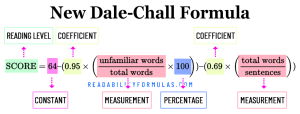In a bustling coffee shop, a young writer sits hunched over her laptop, her fingers flying across the keyboard. She pauses, her eyes scanning the crowded room. She notices a group of students engrossed in a textbook, a businessman skimming through stock news on his laptop, and an elderly couple sharing a community newspaper. It’s a moment of revelation for her—each person engaged with written words, yet each with a different level of understanding and interest. This scene perfectly embraces the advice from Robert Gunning, creator of the FOG Index: know your readers’ needs, interests, and preferences so you can write clearly and effectively to them.
Here are Robert Gunning’s top tips to write for your readers:
TIP # 1
It’s common sense, but not all writers obey it: write from the viewpoint of the reader. Understand the reader’s vocabulary, the type of words that best transfer facts and ideas, and the reader’s tolerance for complex or “hard” words.
“The reader is the most important person in the writer’s mind. Without the reader, there is no writing.” — Maya Angelou, renowned American author, poet, and memoirist
TIP # 2
Know what patterns and sentence lengths your readers can process without fatigue. The goal is to hold the reader’s interest without causing mental fatigue. Strike a balance among sentence complexity, variety, and text flow.
Let’s go deeper into this topic:
- Sentence Structure: Monotony is equally tiring as complexity. Use a mix of simple, compound, and complex sentences to engage readers. For example, in narrative writing, you can use short, punchy sentences and longer, more descriptive ones—this creates a rhythm that holds the reader’s interest. Short sentences add impact and pace; longer ones detail imagery or explanations.
- Audience Endurance: Different readers have different tolerance levels for complex sentences. Young students and ESL readers benefit from shorter, simpler sentences. In contrast, academic or professional audiences can tolerate longer, more complex sentences packed with information.
- Purpose: A text’s purpose influences sentence patterns and lengths. In instructional writing (such as manuals), writers use short, direct sentences to convey clear steps of action. In literary prose, writers prefer long, winding sentences to build atmosphere or develop characters.
- Context: Context also dictates sentence structure. Action scenes in stories thrive on short, brisk sentences that mimic the quick pace of events. Conversely, reflective or descriptive passages may use longer sentences to unpack details or introspection.
- Reader Retention: Long, complex sentences overload reader’s cognitive resources, impacting comprehension and retention. When writing educational or informative content, break down complex ideas into shorter sentences. Short sentences use less cognitive resources and increase the reader’s ability to grasp information quickly.
- Feedback/Revision: Regular feedback from readers or using readability tools can highlight how well your sentence structures are working. Revise your writing based on this feedback—it can help fine-tune sentence lengths and patterns.
“The first draft is just you telling yourself the story. The art of writing is in the rewriting, with the reader in mind.” — Bernard Malamud, American novelist and short story writer
TIP # 3
Transitions and pacing can prevent reader fatigue. Smooth transitions between sentences and ideas flow more naturally—it makes complex content more digestible. Pace the information delivery thoughtfully; do not bombard the reader with too much information at once.
TIP # 4
Effective communication is a dynamic process. Writers should write in a style that engages readers throughout the text and encourages them to take action. Here’s how to do it:
- A Compelling Message: Writing effectively starts with a clear and compelling message. Clearly identify the main points; align each point with the reader’s needs, interests, or values. This clarity engages readers while leading them towards the intended action.
- Audience Profiling: Again…know your readers. Think about the reader as an individual, even in cases where you don’t know the exact readership. Good writers align their message with the reader’s interests, readability level, and background.
- Persuasive Techniques: Persuasive techniques like storytelling, vivid imagery, and emotions can engage readers more deeply. A well-told, heart-felt story can connect with the reader, making your message more memorable and influential.
- Call to Action: A clear call to action (CTA) can encourage readers to take the next step. Make the CTA direct, easy to follow, and relevant: whether it’s signing up for a newsletter, buying a product, following instructions, or changing a habit.
- Build Interest: Find ways to hold your reader’s interest. Use a mix of sentence structures, lively language, relevant examples, etc. Answer potential questions or objections the reader might have.
- Structure Flow: The organization of content should follow a logical structure. Guide the reader through the information in a coherent and persuasive manner. This structure might present a problem, discuss the solutions, and end with a powerful conclusion or CTA.
- Consistent Messaging: Sometimes encouraging action requires repeated exposure to the message. Consistency across different mediums and repetition over time can reinforce the message and prompt action.
“Your writing voice is the deepest possible reflection of who you are…In your voice, your readers should be able to hear the contents of your mind, your heart, your soul.” — Meg Rosoff, award-winning American author
TIP # 5
Robert Gunning emphasized this Golden Rule: “Write unto others as you would be written to.” Translation: consider the clarity and accessibility of your writing just as you would expect from others.
- The core of the Golden Rule is the concept of reader empathy. To write effectively, know your reader’s background knowledge, topic familiarity, and potential barriers to understanding.
- Prioritize clarity and simplicity. Use clear and straightforward language; avoid jargon and unneeded complexity. Clarity ensures the reader will understand your message without confusion. Good writers do not “write down” to their audience, not even to children, or “write up” to an audience, not even to college professors. All readers prefer clear and straightforward writing.
- The Golden Rule extends to how organized your writing is. Readers appreciate writing that flows logically and naturally. It helps them locate and digest content more easily. Use headings, subheadings, bullet points, and callouts, etc. to break up the text and make it more digestible.
- Edit, revise and proofread diligently. Just as you would expect error-free and polished writing from others, deliver the same quality to your readers.
TIP # 6
Even specialized publications, like The Wall Street Journal and National Geographic, publish accessible content to attract a broader readership. Their content is usually 2-3 grade-levels below a college reading level. This underscores why we should write clearly for all audiences, regardless of your readers’ education. For topics that need prior knowledge, add background details for low-level readers without over-simplifying for the expert. Achieve this through sidebars, footnotes, or links to resources.
“You write to communicate to the hearts and minds of others what’s burning inside you, and we edit to let the fire show through the smoke.” — Arthur Plotnik, author of The Elements of Editing
TIP # 7
In a world that’s increasingly interconnected, writers need to be culturally sensitive. Be aware of different cultural norms, values, and beliefs. Avoid stereotypes—they can be harmful and offensive. Consider factors like race, ethnicity, gender, age, sexual orientation, and disability. Writing should embrace cultures in a nuanced and respectful manner.
Writing is more than expressing ideas; it’s about tailoring your message directly and effectively to your readers. Use these tips to transform your writing in not only style and clearness—but in the way you communicate to your readers. Craft each word, sentence, and paragraph for expression, connection and comprehension.
—END—
Scott, Brian. “What Every Writer Must Know About Their Readers.” ReadabilityFormulas.com, 3 Dec. 2024, https://readabilityformulas.com/what-every-writer-must-know-about-their-readers/.








